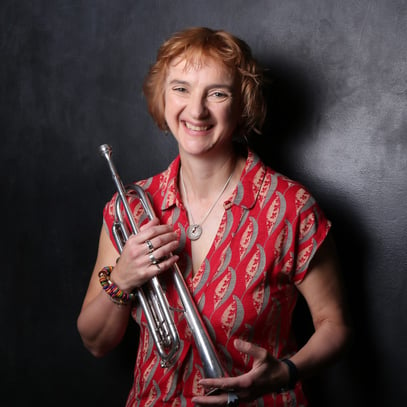Search for topics or resources
Enter your search below and hit enter or click the search icon.
September 12th, 2022
3 min read
By Ewan Moore
.jpg?width=1552&height=630&name=New%20Project%20(11).jpg)
Looking for new arrangements for your school band library? Kay Charlton’s ‘Are You Ready?’ books are an excellent resource that focus on bringing out the fun in teaching young players, while never losing sight of the fact that the best pieces should be accessible and great-sounding to keep kids engaged.
We spoke with Kay about what sets the series apart from other educational material out there, why ‘Are You Ready?’ was built with the help of student feedback, and the process of writing pieces with genuine feeling behind them.
Before we dive in, take a look at the entire ‘Are You Ready?’ library below to see which might be the best fit for you:
Kay’s wealth of experience certainly isn’t to be sniffed at. A trumpet player, educator, and composer, she completed her MA in Music Education at Trinity Laban Conservatoire of Music and Dance in 2018, and was awarded the Director’s Prize for Excellence in Music Education. Kay has also been a guest lecturer on instrumental tuition at Leeds College of Music and Trinity Laban, and has written resources for LSO Discovery and LPO Creative Classrooms. She also wrote the brilliant ‘How to teach Whole-Class Instrumental Lessons, 50 Inspiring Ideas’ (Collins Music, 2020).
Kay explains the origins of ‘Are You Ready?’ are actually quite simple: she felt there was a shortage of music suitable for teaching whole class instrumental groups.
“I worked hard to compose pieces that are fun and accessible, starting with a disco track that is played on one note and building from there to two notes, three notes etc,” she tells us. “I tested all the music on my pupils and took their feedback on board. My philosophy of ‘Are You Ready?’ is that it doesn’t matter too much what you play, for the first few tunes at least, as long as you play something in the right place and with feeling - the backing tracks make that easy to do. The pieces are in lots of different musical styles, and there are lots of chances to improvise too, which is important.”
Kay realised from an early age that music was the only path she wanted to follow. “It was the thing I enjoyed most at school and was best at. I never really considered doing anything else,” she says.
“I’ve always loved listening to all sorts of music and have been lucky to play professionally and travel the world doing that. There is lots of variety in my career as a musician - originally teaching was secondary to playing, but my education work has grown in importance, alongside composing and writing about music education. Getting music published is a boost too and has encouraged me to write more.”
For Kay, composing something new usually starts with a melody line, then the harmony and feel of the piece start to come together. Then she starts to arrange the music. This process, however, usually depends on who she’s writing for. She explains that sometimes she likes to start with a title or concept for the piece - particularly if it’s for kids.
“The main thing that’s changed over the years is technology,” Kay adds. “I use notation software and now compose a lot of backing tracks using Logic - which I’m still learning to use!”
One of the most important things Kay keeps in mind when composing is who exactly she’s writing for and what their playing level is. She wants the music to be accessible, and for everyone involved to get something interesting to play - even if they’re beginners.
‘Are You Ready? pBuzz’ is obviously a book that’s particularly close to our hearts, given our connection to the instrument. Like much of Kay’s work, the pBuzz is all about making music accessible and fun for younger players - so how did Kay find putting together pieces for it?
“The KS1 pBuzz tunes were really fun to write!” she says. “They cover KS1 topics such as space, dinosaurs and mini beats and have simple sections to play on the pBuzz. It’s a great way to get started on brass.”
Being able to listen to and learn about lots of different styles of music is also one of the best pieces of advice Kay would give to any younger players out there who want to pursue their musical ambitions. This belief is absolutely reflected in the ‘Are You Ready?’ books, which highlight a number of genres and musical styles. After all, understanding what you don’t like and why is just as important as working out what you do enjoy!
These days, Kay plays professionally with the Bollywood Brass Band, and still finds absolute joy in sharing great music with as many people as possible.
“We’ve been playing some of the same songs for many years,” she admits. “But playing them live? In front of different audiences? I never get bored.”
Browse a full range of educational resources and compositions at Warwick Music.
After seven years writing about video games, Ewan made the jump to the music instrument industry to stop his family asking when he was going to get a real job. Mostly, though, he adores music and is passionate about its vital role throughout life - especially in education. He also played guitar in several bands with deeply embarrassing names that won't be revealed here. With a degree in journalism from an NCTJ-accredited university under his belt, Ewan uses everything he learned as a writer over the last decade to help answer any questions you might have about pBone Music in an accessible (and hopefully entertaining) way. Because if you can write 1,000 words on SSDs and ray-tracing, you can explain why plastic instruments are accessible, sustainable, and fun.